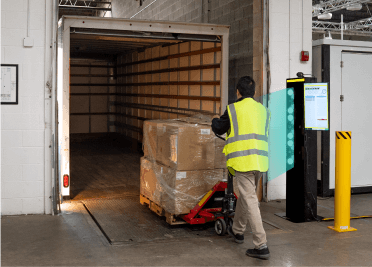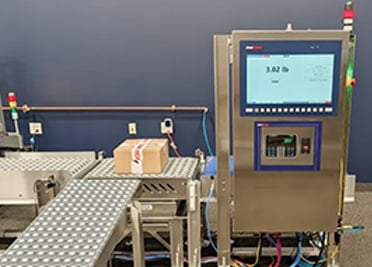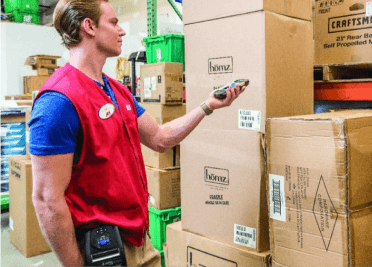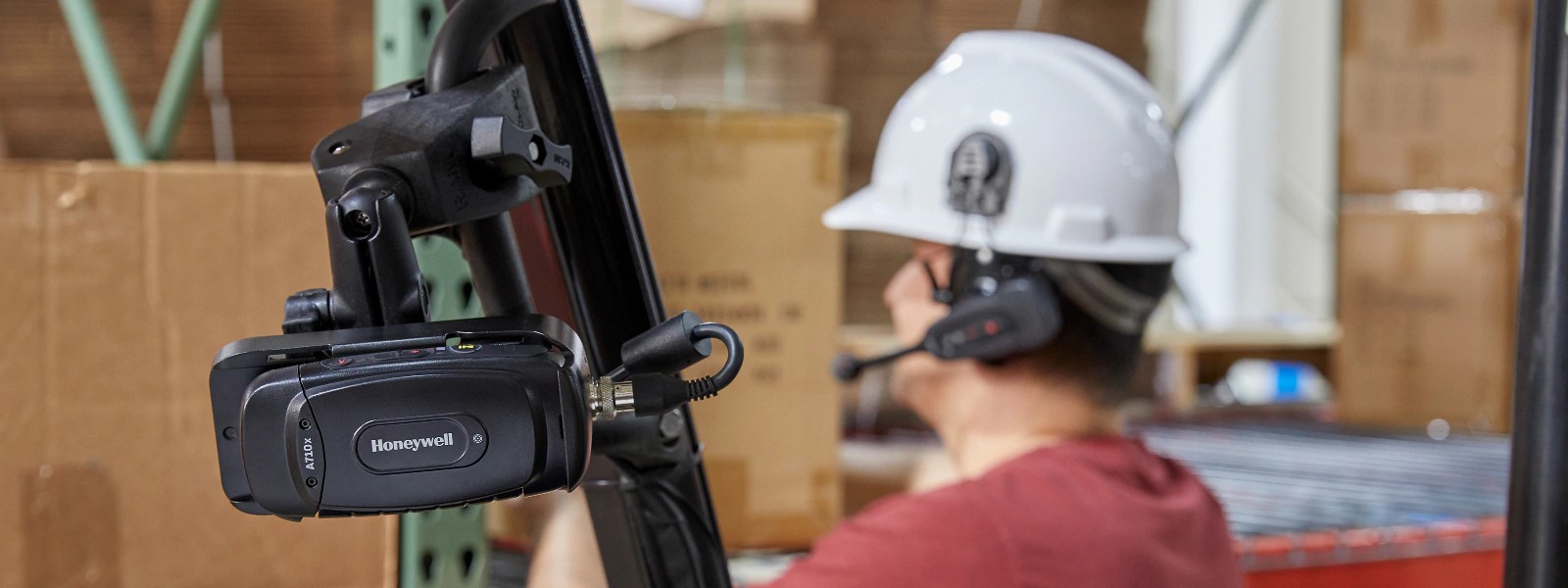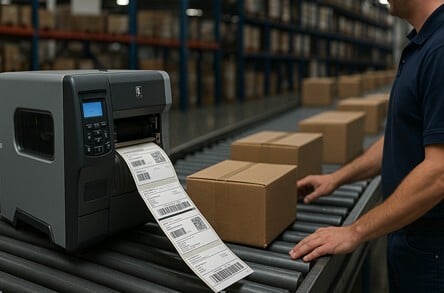Picking is the most labor-intensive operation within the warehouse, making it one of the most popular supply chain processes to improve with voice technology. Much of the impact to a business comes from four key criteria:
- Reduced operational costs
- Increased workforce productivity
- Improved customer satisfaction
- Enhanced operational agility
Let’s take a closer look at exactly how voice affects all aspects of the picking workflow.
Improved Operational Accuracy
When customers or stores receive orders with items missing, incorrect quantities, “extra” (unordered) items, damaged goods or incomplete/inaccurate paperwork, inefficiencies ripple throughout the supply chain. Labor and transportation costs increase, repeated pick and delivery activities interrupt and reduce productivity, order fulfillment falls behind schedule, and payments are slowed. The penalty for not getting the order right the first time is significant.
Depending upon the value of goods and process costs, errors in the picking process can cost anywhere from $10 to $250 each. For sizable operations, this can translate into millions of dollars in hidden costs.
Typical reductions in the number of errors, through the use of voice-directed picking:
- 50–90% improvements for paper-based operations
- 1–15% improvements for pick-to-light operations
- 8–25% improvements for RF scanning operations
Reduced Errors. Operational processes involving people are filled with bountiful opportunities for human error. Items can be picked from the wrong slot, in the wrong quantities, etc. Common order fulfillment errors include:
- Item not received (out of stock)
- Too few received (or delivered damaged)
- Too many: more items received than ordered
- Wrong item received (e.g., wrong version)
- “Extra” items (not on the P.O.)
- Proper quantity received, but paperwork does not match
- Items not labeled correctly
- Paperwork not matching expectations
- Items not received within the committed time frame
Companies use voice-directed picking because of its ability to greatly reduce such errors, resulting in order accuracy approaching 100%. By leveraging a voice-directed, hands-free/eyes-up technology, order error rate is typically reduced by 50–90%.
When orders are delivered correctly the first time, costs are avoided in many areas of the value chain, including administrative changes, re-picks, re-delivery and cost of lost sales. For a more comprehensive perspective on items that contribute to the “per-error cost,” please refer to the section at the end of this document.
Accuracy Aids Productivity. Improvements in pick accuracy (as discussed herein) provide tangential benefits to warehouse staffing levels and pick productivity. For example:
- Reducing Auditing Reduces Labor Costs. With a significant improvement to pick accuracy, the number of order auditors — people in a quality assurance (QA) role — can be greatly reduced. The time each picker spends validating accuracy can become far more selective. Dedicated QA staff can be redeployed to other warehouse tasks.
- ASN Privileges. Increased pick accuracy is a key qualifier for participating in Advance Ship Notification (ASN) programs. ASN programs include entitlements, which can result in downstream delivery efficiencies, including:
- Dock door delivery prioritization (“go to the head of the line”)
- Drop and go without inbound delivery audit (or token audit only)
- These special privileges — extended only to high-accuracy suppliers — can easily reduce delivery times by two-thirds, permitting each driver to execute more deliveries every day.
- On Time: Fewer Job Interrupts. Picking orders correctly the first time helps all orders stay on track for timely delivery. Companies with high accuracy avoid losing time repeating picking and re-shipping orders a second time. This avoids de-prioritizing existing pick work in order to correct prior errors through high-replacement orders.
Increased Worker Productivity
Improving warehouse productivity results in companies being able to service increased product selection (growth in the number of SKUs) and higher order volumes without growing square footage or staffing.
By combining hands-free picking operations with warehouse management system (WMS) or similar software, voice-directed picking productivity improvements can reach:
- 10–35% for paper-based operations
- Up to 30% for pick-to-light operations
- 10–35% for RF scanning operations
Picker Efficiency (measured in lines per hour). Real-time connectivity with warehouse workers provides the necessary visibility to optimize operations. Voice picking enhances WMS use in reducing order-cycle times through new optimization strategies in warehouse layout and item selection (picking). For example, an operation performing discrete order picking might use voice technology to move to batch picking to multiple orders.
Effective designs reduce travel time between pick locations and the handling of exceptions (shorts, damage, etc.). A WMS capable of task-interleaving can permit a worker to perform multiple roles dynamically, based upon location, skills and current business priorities — for example, blending a cycle-counting task while performing a replenishment activity.
Hands-Free. Picker productivity is gained from the hands-free, eyes-up capability of voice-directed technology. Workers avoid the need to handle paper or devices multiple times during each pick, resulting in work being accomplished with fewer motions and steps.
Environmental conditions also add to the difficulty in using technology in many warehouse processes, but more frequently in picking. For example, workers in cold storage wear gloves, making it hard to operate keyboards for data input. These same workers can easily use voice to enter data such as items picked and catch weights.
Voice picking is typically well-suited to the following environmental situations:
- Protective clothing in use (gloves in cold storage, protective suits in chemical storage, etc.)
- Motorized equipment (e.g., both hands occupied when operating a lift truck)
- Climate extremes (e.g., outdoor data collection during stormy weather)
- Special manufacturing processes (such as hazardous materials where worker concentration is paramount)
- Situations where both hands are required to safely move goods
Rapid “New Hire” Effectiveness. Often staffed as an entry-level position, warehouse picking is subject to significant staff churn, resulting in costly training and onboarding expenditures. Typically, a warehouse sees rapid turnover in new hires, as workers (and the hiring company) frequently use a short assessment period to determine whether the work is a mutual fit.
Prior to voice-directed picking, new workers are frequently brought up to speed by working alongside an experienced worker (with a slight detriment to the “trainer’s” pick performance). It is not uncommon for it to take months for a new worker to know the layout, products and optimized processes that result in meeting corporate productivity expectations. Honeywell’s approach accelerates the learning curve for new workers, achieving corporate production metrics within the first few hours or shifts of use.
Seasonal Labor or Temporary Workers. If integral to your business or staffing requirements, the simplicity in adding new workers to a Honeywell Voice system makes it easy to include temporary or seasonal workers within the automated voice-directed picking solution. A temporary resource can be brought up to speed the first day on the job, without sacrificing accuracy of work.
Reduced Overtime. Improved picker efficiencies — a greater number of line items being accomplished per worker, per hour — reduce the exposure to more expensive overtime hours. Because of the ability for voice solutions to improve not just the average worker, but to bring up even the bottom performers, voice enablement can help provide greater flexibility when it comes to staffing your warehouse operations.
Get “in the Zone”. Years of voice picking deployments have uncovered that worker behavior changes actually enhance picking processes and lead to greater efficiencies. Observations reveal pickers who receive instructions via a headset get into a “picking zone” (i.e., a work rhythm), becoming less distracted, and thereby increasing their hourly output.
Timely Replenishment. When integrated with other key applications like cycle-counting and replenishment, voice-directed picking enhances real-time replenishment notifications and subsequently reminds the pickers to return unpicked items as they become available. This minimizes the need for backtracking at the end of a shift, or shipping incomplete orders and expediting additions/missed items.
Incentive Programs. Another positive factor influencing productivity is the enablement of incentive or bonus programs based upon personal production. With the real-time visibility that voice-directed picking provides to individual performance, companies can track and reward each worker for performing at or above corporate metrics. At any time, pickers can simply ask for their current performance status, ensuring that they are aware of their own performance level. This drives improved efficiencies and decreases order-cycle time.
Savings Are Real. Let’s take a look at what that means in possible savings. If an employee earning $24,500 per year had a 15% savings in productivity by using voice, it would save the company $3,675. The warehouse/DC could realistically expect to realize the following:
- 10 employees: $36,750 savings
- 20 employees: $73,500 savings
- 30 employees: $110,250 savings
- 40 employees: $147,000 savings
- 50 employees: $183,750 savings
Staffing Improvements and Labor Savings
Often, we can get carried away by focusing on the actual financial ROI. With voice, we see dramatic improvements in staffing and labor. Voice technology removes the need for the user to have to read device screens or paper lists while performing their process tasks or traveling. Freeing a user’s eyes and hands enables that user to concentrate on their surroundings while performing their process or traveling, thus increasing safety.
Reduced Staff Turnover. Voice picking contributes to a reduction in staff churn and turnover in a number of ways:
- Increasing the productivity of more senior workers reduces the need for entry-level or inexperienced workers (where churn rates tend to be higher).
- Increasing the productivity of new hires improves their effectiveness (success) and thereby their impact on the business.
- Workers see the company investing more strongly in them and have an increased sense of value.
- The “cool factor” of using modern technology (which also reduces the attraction to jobs at other companies not using similar technologies)
- Non-native speaking workers use the voice system as a way to build language skills in the predominate local language, increasing promotion opportunities (and their overall value to the company).
- Incentive programs (as previously mentioned), where individual performance can be recognized and rewarded
Simplified Hiring. Voice-directed solutions simplify hiring, as there is less emphasis required on spoken or written language skills. The multilingual capabilities of voice solutions enable workers to work in the dominant local language, or a non-native language/dialect. Honeywell Voice offers the following multilingual capabilities:
- System speaks to workers in 46 languages/dialects in 85 different voices
- System understands workers in 68 different languages/dialects
Safe for the Hearing Impaired. Unless the operator is 100% hearing impaired, they can most likely use Honeywell Voice successfully. The Text To Speech engine allows users to choose their preferred voice, pitch and volume to dial it into a frequency and volume that almost any operator is comfortable with. We have a number of different headset styles, including a cupped style that eliminates background noise.
Improved Safety and Reduction in Lost Time
Hands-free and eyes-up technology increases worker safety by removing distractions (such as looking down at paper or a device screen), enabling workers to be more aware of their surrounding environment. Increased awareness leads to fewer injuries and deaths, stabilizes staffing predictability, and reduces legal liabilities while — over sufficient time — lowering insurance costs.
Most safety benefits are realized outside the initial project payback period, but have valuable business impacts nonetheless. For example:
- Worker injuries caused by moving goods are reduced, as both hands are free to handle items and workers are more aware of their surroundings. Using two hands has also been shown to reduce product damage.
- Worker awareness helps avoid injuries from lift trucks. (In the United States, OSHA reports 95,000 injuries annually from accidents involving powered industrial trucks.)
- Heavy equipment and lift trucks can lead to major injuries and in some cases, even death. According to the U.S. National Institute for Occupational Safety and Health (NIOSH), a person is killed once every three days in an accident involving a lift truck. This is traumatic to all involved, and has also resulted in legal settlements of millions of dollars.
- The reduction in injuries, repetitive stress claims and accidents has a cumulative effect on the cost factors (rating basis) for insurance taxes such as Worker’s Compensation rates.
Greater Regulatory Compliance. Another form of safety is the tracking of products and their sources (frequently driven by public health safety regulations such as the U.S. Bioterrorism Act of 2002). Recent examples of tainted foods and dangerous lead levels in toys have accelerated governmental involvement and increased the requirement for traceability. Industry organizations are also promoting similar safety initiatives, such as Produce Traceability Initiatives (PTI) using global data collection standards such as GS1.
Voice solutions — at times in collaboration with other data collection methods like RF scanning or radio frequency identification (RFID) — can easily capture key tracking information (production batch, lot number, dates, serial numbers, etc.), enabling companies to comply with a growing number of local, national and international regulatory requirements.
Advantages of Analytics
Analytics of the data and transactions generated by Honeywell Voice serve as a way to gain more productivity from warehouse/DC workflows. Analytics can help determine when it makes sense to move workers from one zone to another based on workflows. Analytics can spot patterns that help an organization fine-tune the use of voice-directed work. For example, analytics can tell if a worker might be adequate or good on his or her pick rate but is using more “utterances” than normal back to the voice system. This sort of pattern might indicate a problem such as incorrect headset positioning, which if adjusted, might further help the productivity of the worker.
Honeywell’s analytics solution has been used to spot instances when the voice system’s commands have been sped up to a higher-than-recommended pace in an effort to achieve greater throughput, which has resulted in more repeat “say again” utterances. In this case, the company slowed the system down slightly, and by slowing it down, their workers actually went faster.
Improved Operational Agility
Today’s consumers have increasing expectations; these have a tremendous impact on the warehouse. As consumers desire more choice, the number of products (SKUs) increases. As customers’ product loyalty becomes more transient, slotting for high movers versus slow movers is ever-changing.
To meet such demanding supply chain dynamics, companies increasingly invest in advanced warehouse optimization software. These systems guide the best placement of goods given current demand, provide the most efficient picking routes and pick strategies, handle replenishment and inventory control, and interleave staff tasks.
Voice technology has a key role in these advanced strategies, providing real-time visibility and voice direction to workers across the warehouse. As operational strategies change, much of it is transparent to workers as they merely continue to respond to voice directions. For example, a worker may be unaware that pick strategies have shifted from batch to zone picking. Their work remains constant; they hear where they are to go and pick the items as directed. This transparency suits the dynamic nature of warehouse operations by allowing managers to better:
- Change pick strategies
- Change SKU locations
- Introduce new SKUs
When companies want to introduce new processes to workers, Honeywell Voice simplifies training and provides ever greater flexibility to not only extend voice to improve operations, but increase bottom-line savings.
Going Green
Voice-directed technology can even help enable more paperless operations, which can lead to:
- Reduction in fixed assets
- Lower material costs
- Less support staff time and costs
Voice technology enables work to be accomplished with fewer workers. This can reduce the capital requirements for lift trucks and related fixed assets that support picking operations. Optimized routing of lifts further reduces the replacement cycle for consumables such as batteries and propane.
Voice can also remove the need to print orders, reducing consumables (paper reams, toner, drums, etc.) and the need to replace printers as frequently.
Migrating to paperless operations (save for labels) also reduces administrative staff time. No longer does the office staff need to spend hours creating and distributing paper orders, or subsequently keying in pick confirmations, pick amendments and order details like catch weights.
Conclusion
Honeywell voice-directed solutions are used by nearly one million mobile workers every day, throughout the world, in a variety of tasks/workflows, in almost every kind and size of DC/warehouse operation. Honeywell voice-guided solutions have been proven to increase productivity by up to 35% and accuracy to 99.99%+. For example, in picking processes where workers follow a series of instructions for specific pick locations, products and quantities, these tools provide needed guidance and verification at every step. Voice is available in more than 35 languages and has been proven to dramatically reduce training and onboarding time, especially in peak seasons with highly transient workforces.
To learn more about Honeywell Voice contact our AbeTech solution experts today!
